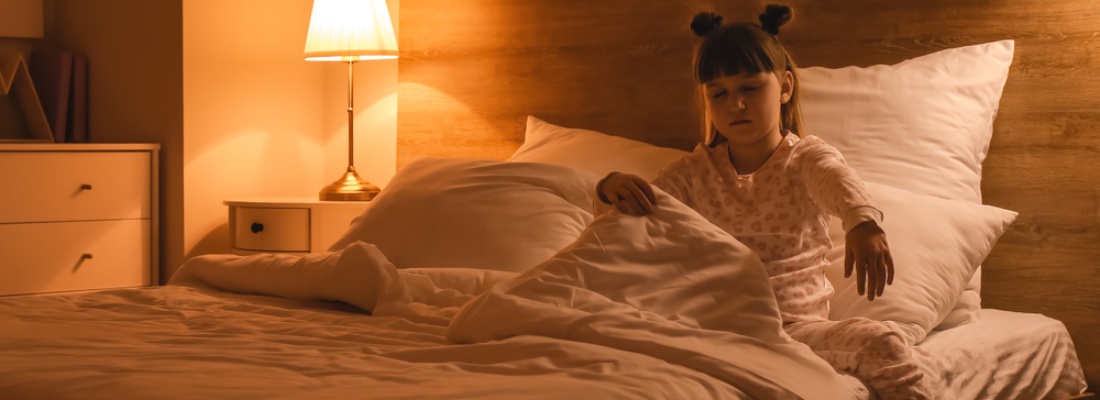 Sleepwalking in kids is a curious and sometimes concerning phenomenon that many parents encounter at some point during their child’s development. Finding your child wandering around in the middle of the night leads to various questions: is it safe? Why is it happening? Should I wake them up or consult a doctor? While understanding the triggers, risks and its response helps to ease your concerns and keeps your child safe during these times. However, in this blog we will cover everything you need to know about sleepwalking in children, its causes and patterns and much more.
Sleepwalking in kids is a curious and sometimes concerning phenomenon that many parents encounter at some point during their child’s development. Finding your child wandering around in the middle of the night leads to various questions: is it safe? Why is it happening? Should I wake them up or consult a doctor? While understanding the triggers, risks and its response helps to ease your concerns and keeps your child safe during these times. However, in this blog we will cover everything you need to know about sleepwalking in children, its causes and patterns and much more.How Common is Sleepwalking?
Sleepwalking (somnambulism) occurs when a person gets up in the middle of the night and does other activities. Walking depends on various conditions; sometimes, it is harmless, like waking up and just sitting and occasionally dangerous, like wandering outside. Regardless of their condition and their sleepwalking activities, they usually do not remember getting up after sleep.Sleepwalking in kids is more common than you might think. It affects approximately 15% of children, most occurring between the ages of 4 and 12. However, the condition peaks in the early school years and often resolves independently as the child ages. Moreover, it is rare for sleepwalking in kids persist into adulthood. As per studies, it has been found that a family history of sleep disorders increases the likelihood of sleepwalking episodes continuing later in life.Symptoms of Sleepwalking in Kids
Sleepwalking usually involves several features:Poor Coordination: Awkward and clumsy movements.Partial Wokeness: You become active but are half asleep.Lack of Memory: You most likely have no idea about the activities you have done in Sleepwalking.Dream-acting: You also might act out behaviors that line up with the dream you are having.Sleep Eating: You are most likely to eat inedible items or foods in your sleep and gain weight from the calories consumed during sleep.Common Triggers for Sleepwalking in Kids
Understanding the causes of sleepwalking in kids can help parents manage and reduce its frequency. Some of the most common triggers include:1. Sleep Deprivation
Lack of sleep is one of children’s most significant triggers of sleepwalking. When children don’t get enough rest, their bodies may fall into deeper sleep, increasing the chances of partial arousal and sleepwalking episodes.2. Irregular Sleep Schedules
Inconsistent bedtime routines can disrupt a child’s natural sleep cycle and contribute to sleepwalking. Establishing a consistent bedtime and wake-up time can help stabilize sleep patterns.3. Stress and Anxiety
Emotional stress or anxiety can interfere with a child’s sleep. Whether related to school, family dynamics, or social issues, unresolved stress can manifest as sleep disorders, including sleepwalking.4. Illness and Fever
A child with a fever or other illness may experience disrupted sleep architecture, increasing the likelihood of sleepwalking.5. Medications
Certain medications, especially those that affect the central nervous system, can lead to sleepwalking in children. Always consult a pediatrician if you suspect a medicine may contribute to sleep-related behaviors.6. Genetics
If one or both parents experience sleepwalking, their child will likely do the same. Genetics can play a significant role in sleepwalking in kids.Concerned About Your Sleep?
Learn how our in-home sleep study can help diagnose sleep disorders in the comfort of your home.
Is Sleepwalking Dangerous for kids?
Sleepwalking for kids is usually not dangerous, but there are some potential safety risks. A child could trip, fall downstairs, or walk outside. Moreover, it is crucial to make necessary measures for your child so that it doesn’t affect its development. Furthermore, it is also essential to make the home environment as safe as possible:
- Install safety gates at the top of the stairs.
- Keep doors and windows locked.
- Remove sharp objects or tripping hazards from the child’s room.
- Consider using door alarms or motion detectors if episodes are frequent.
How to Prevent Sleepwalking in children?
There is no guaranteed way to prevent Sleepwalking in children, but these tips can help reduce the frequency:
- Ensure Adequate Sleep: Children need age-appropriate amounts of sleep. Avoid late nights and promote a calming bedtime routine.
- Create a Stress-Free Environment: Address any sources of stress in the child’s life. Open communication and relaxation techniques can be beneficial.
- Maintain a Regular Sleep Schedule: Consistency helps regulate the body’s internal clock.
- Limit Stimulants: Avoid caffeine and sugar close to bedtime.
- Avoid Screen Time Before Bed: Reduce exposure to blue light from phones, tablets, or TVs at least an hour before sleep.
What Causes Sleepwalking in Kids?
Sleepwalking typically occurs during the deep non-REM (rapid eye movement) sleep stages. While it may seem alarming to watch your child wander the house seemingly unconsciously, sleepwalking is often a temporary phase many children outgrow. But what exactly triggers it?
1. Genetics Play a Role
If you or your partner experienced sleepwalking as a child, there’s a higher chance your child will, too. Studies suggest that sleepwalking can run in families, with children having a 45% risk if one parent sleepwalked and up to 60% if both did.
2. Sleep Deprivation
When children don’t get enough sleep, their brain’s transition between sleep stages can be disrupted, increasing the likelihood of sleepwalking episodes. Ensuring your child has a consistent bedtime routine and sufficient rest can help minimize these occurrences.
3. Stress and Anxiety
Emotional stress, anxiety, or significant changes in routine (like moving to a new house or starting school) can contribute to sleepwalking in kids. Children often process these emotions during sleep, sometimes resulting in nighttime wandering.
4. Illness or Fever
High fevers and illnesses that disrupt standard sleep patterns can sometimes trigger sleepwalking. This is because the body is under stress, affecting the quality and depth of sleep.
5. Sleep Disorders and Medical Conditions
Conditions like sleep apnea or restless leg syndrome can fragment sleep, making sleepwalking in kids episodes more likely. In rare cases, medical issues such as seizure disorders or head injuries can also be contributing factors.
6. External Sleep Disruptions
Environmental factors like loud noises, sudden lights, or even a full bladder during deep sleep can trigger sleepwalking in kids.
Treatment of Sleepwalking
Be gentle with your child if he/she is sleepwalking. Try to guide them back to bed gently. If your child sleepwalks, it’s important to remain calm and respond with care. Avoid trying to wake them up, as it may cause confusion or agitation. Instead, speak to them soothingly and gently guide them back to bed. To help keep your child safe during sleepwalking episodes, consider the following precautions:
- Install safety measures on the top or front of the doorways.
- Ensure you to look at all windows or doors at night.
- Use door and window alarms or place locks high enough that your child can’t reach them.
- Clear the floor of toys, rugs, or other objects that could cause tripping.
- Keep sharp or fragile items away from the bed area.
- Lower your water heater temperature to reduce the risk of accidental burns.
- Store keys and other potentially dangerous items out of your child’s reach.
Caring for your Kid’s Sleepwalking
Sleepwalking in kids can be unsettling, but it’s often a benign phase of childhood. Once you understand its triggers, patterns, and safety measures, it can help you handle these nighttime adventures with confidence and care. However, if you stay observant and proactive throughout your child’s wellness journey you can support you can ensure their safety during sleepwalking episodes.
Ready to Take Control of Your Sleep?
Book your appointment today and start your journey toward better sleep health.

